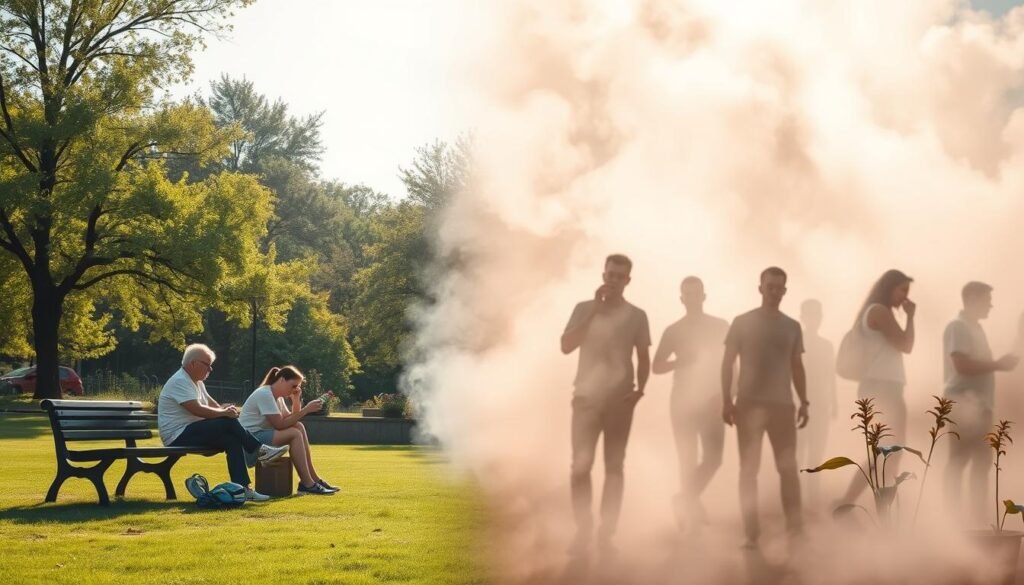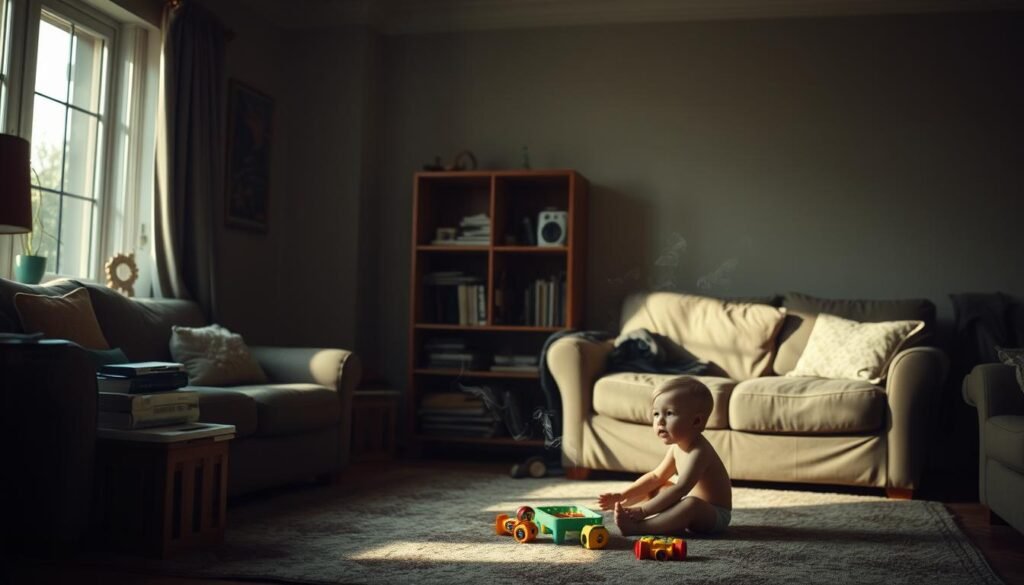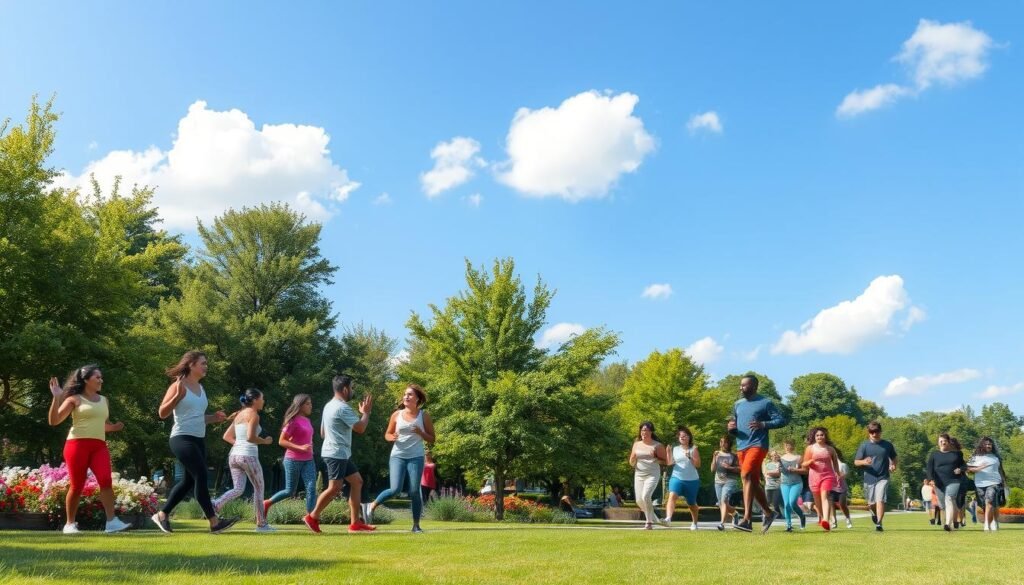Secondhand smoke is more dangerous than many realize. It contains over 7,000 chemicals, around 70 of which can cause cancer. This puts millions of non-smokers at risk every day. Even short encounters with secondhand smoke can harm your health instantly. And the problems can grow into serious issues over time.
We’ll look at how secondhand smoke, especially from marijuana, hurts non-smokers. We’ll explore the dangers of environmental tobacco smoke and the serious risks from being exposed to it.
Secondhand smoke can cause lung cancer in people who’ve never smoked. It’s also linked to serious conditions like heart disease and strokes. Kids are especially at risk. They can suffer from bad health effects due to e-cigarette vapors too. We’ll also talk about how quitting smoking can help protect families and those at risk.
Learn more about the health risks of secondhand smoke.
Key Takeaways
- Secondhand smoke contains over 7,000 chemicals, including many carcinogens.
- There is no safe level of exposure to secondhand smoke for non-smokers.
- Children exposed to secondhand smoke have a higher risk of severe respiratory infections and asthma attacks.
- Public policies aimed at reducing secondhand smoke exposure are crucial for protecting public health.
- Thirdhand smoke remains a danger long after tobacco has been smoked, affecting children and pets.
- Adult non-smokers exposed to secondhand smoke face significantly increased cancer risks.
- Smoking cessation can lead to immediate health improvements for both smokers and non-smokers alike.
Introduction to Secondhand Smoke
Secondhand smoke, or passive smoking, is harmful to people who don’t smoke. It comes from the lit end of tobacco products and the smoke that smokers breathe out. This smoke has over 7,000 chemicals, including 69 that can cause cancer. Knowing about these dangers is key to understanding its effect on health.
In the U.S., cigarettes are the main source of secondhand smoke. Pipes and cigars also add to the problem. This smoke can cause lung cancer in people who have never smoked. Studies also show it might lead to other cancers, affecting both adults and children.
Laws are important in fighting against passive smoking. In the U.S., there are federal laws that limit smoking in places like planes, buses, and public buildings. Also, many states and cities have made rules to stop smoking in restaurants, bars, and other places. These laws help make smoke-free environments more common.
More people now understand the risks of secondhand smoke. This has led to more talks and actions to protect nonsmokers. It’s crucial to know how dangerous secondhand smoke is as we work together to solve this health issue. Informed choices and strong laws are vital to protect everyone’s health.
What is Secondhand Smoke?
It’s important to know what secondhand smoke means and why it’s bad for health. It is tobacco smoke that people around a smoker breathe in. This smoke comes from the smoker’s exhaled breath and the burning end of cigarettes, cigars, or pipes. Secondhand smoke has over 7,000 chemicals. Many of these are harmful and can cause cancer and heart problems.
Definition and Composition of Secondhand Smoke
Secondhand smoke is full of dangerous stuff. It has over 4,000 toxic substances, including irritants and cancer-causing agents. Smoke blowing out from the lit end of tobacco products is very harmful. It has lots of dangerous particles. People around this smoke could get serious health issues, showing how risky it is to be near someone smoking.
Different Sources of Secondhand Smoke
The main places secondhand smoke comes from are:
- Cigarettes
- Cigars
- Pipes
- Hookahs
- Indoors in homes and cars
People who smoke may not realize how long smoke stays in the air. It can stick around for 2 to 3 hours after they’ve finished smoking. That’s why having rules against smoking in homes and cars is a good idea. It’s especially important when kids are around.
| Source | Key Chemicals | Health Risks |
|---|---|---|
| Cigarettes | Nicotine, tar, carbon monoxide | Cancer, heart disease, respiratory illnesses |
| Cigars | Nitrosamines, formaldehyde | Oral cancers, lung disease |
| Pipes | Heavy metals, ammonia | Cardiovascular problems, respiratory issues |
| Hookahs | Carbon monoxide, high tar levels | Cancer, infectious diseases |
Knowing where secondhand smoke comes from helps us make smart choices. It also helps us take steps to protect ourselves and others, especially children and pregnant women, from its dangers.
Health Consequences of Secondhand Smoke Exposure
Secondhand smoke exposure has a big impact on health right away and over time. Knowing the health effects is key to lower risks. This is especially true for people who can’t stay away from it.
Immediate Health Effects
Right after being around secondhand smoke, a person might face several health problems. These issues include:
- Increased heart rate
- Impaired lung function
- Irritation of the eyes, nose, and throat
Immediate effects of secondhand smoke can cause discomfort. They also might point to more serious health concerns. For example, breathing in harmful chemicals triggers the body’s stress reaction. This could lead to sudden heart problems.
Long-term Health Risks
Being around secondhand smoke for a long time brings major long-term risks of secondhand smoke. Over the years, people are more likely to face serious health problems, like:
| Health Issue | Increased Risk (%) |
|---|---|
| Coronary Heart Disease | 25-30% |
| Lung Cancer | 20-30% |
| Stroke | 20-30% |
Research shows that secondhand smoke caused about 1.3 million deaths worldwide in 2019. It’s vital to remember that secondhand smoke has over 7,000 chemicals. About 70 of these can cause cancer. Being exposed regularly greatly increases health risks. This shows why it’s so important to have places where no smoking is allowed.
How Smoking Affects Non-Smokers Through Secondhand Smoke
It’s key to know how smoking impacts those who don’t smoke. Passive smoking, or inhaling secondhand smoke, is harmful. It has many dangerous chemicals that hurt non-smokers’ health. They can get respiratory issues, heart disease, and cancer from it.
Secondhand smoke can increase a non-smoker’s lung cancer risk by 20–30%. More than 7,300 lung cancer deaths among non-smokers in the U.S. are linked to this smoke each year. It also leads to about 34,000 early heart disease deaths in non-smokers annually.
Non-smokers around secondhand smoke have a 25–30% higher risk of heart disease. They also face a 20–30% increased risk of having a stroke. Even short-term exposure can affect your blood flow and raise heart attack risks.
Creating smoke-free spaces in homes and cars can protect everyone, especially kids. Children in smoky environments risk bronchitis, pneumonia, and sudden infant death syndrome (SIDS). Pregnant moms exposed to smoke tend to have low-weight babies.
The data makes it clear: we need actions to lower exposure to secondhand smoke. Such measures protect non-smokers and lead to a healthier society. They help decrease diseases caused by smoking.

Impact on Adults
Secondhand smoke deeply affects adults, bringing serious health problems. It greatly raises the chance of getting heart disease and lung cancer. Knowing about these dangers shows why we must cut down on secondhand smoke wherever we can.
Heart Disease and Stroke Risks
Being around secondhand smoke makes adults more likely to get heart disease. There’s a 25-30% higher risk of catching coronary heart disease from it. Every year, almost 34,000 people die from heart disease in the U.S. because of secondhand smoke. Also, the risk of dying or getting hurt badly from a stroke goes up by 20% to 30%.
This all tells us we need to do more to protect people from secondhand smoke.
Lung Cancer Statistics
Lung cancer dangers from secondhand smoke are just as scary. Adults who breathe in secondhand smoke have a 20–30% higher chance of lung cancer. About 7,330 nonsmokers die from lung cancer in the U.S. each year due to secondhand smoke. This link to higher death rates shows why we need smoke-free places and more public knowledge.
Many studies are still finding out how secondhand smoke causes these problems. They highlight how crucial research and public health actions are. For details on smoking’s effects, check out this resource.
Effects on Children and Infants
Children and infants are very sensitive to secondhand smoke. Many studies have found a link between being around smoke and getting sick. Problems like respiratory infections and Sudden Infant Death Syndrome (SIDS) are more common.
Increased Risk of Respiratory Infections
Secondhand smoke is bad for kids. It makes them more likely to get lung infections, such as bronchitis and pneumonia. Kids exposed to smoke end up in the hospital more often for breathing problems. Every year, between 7,500 to 15,000 young kids need hospital care for these issues.
The harmful stuff in secondhand smoke hurts kids’ growing lungs. This can cause more asthma attacks. It also makes kids miss school because they’re sick with lung problems. Keeping kids away from smoke is key to keeping them healthy.
Sudden Infant Death Syndrome (SIDS) Link
SIDS is a scary risk linked to secondhand smoke. Moms who smoke while pregnant risk their babies’ health the most. Babies with smoking moms have more nicotine in their lungs. It’s very important that parents and caregivers know about the risks of secondhand smoke. Keeping infants away from smoke cuts down on SIDS cases. It also helps keep them healthy overall.

Adults must work to create a safe space away from secondhand smoke for kids. Not smoking inside and having smoke-free homes can make children healthier. For more information on these health risks, check out Dangers of Secondhand Smoke.
Reproductive Health Risks Associated with Secondhand Smoke
Secondhand smoke seriously endangers pregnant women’s health. Exposure can lead to babies being born too early or with low weight. It can also increase the risk of losing the baby. The toxins in secondhand smoke harm the unborn baby. It is crucial to avoid places where people smoke.
About one in ten American workers breathe in secondhand smoke at work. Jobs in restaurants, bars, casinos, and hotels often expose employees to smoke. Places like outdoor work areas and homes don’t always have rules against smoking. This puts many people at risk.
Secondhand smoke affects more than just babies. It can make it harder for people to have children. It can change hormone levels and lower sperm quality. Trying to remove smoke with filters or ventilation doesn’t fully protect against these risks.
Kids are very sensitive to secondhand smoke. Studies show it raises the risk of Sudden Infant Death Syndrome (SIDS). They could also be born too small. Smoke sticks to clothes and furniture, hurting everyone in the house.
This table outlines how secondhand smoke affects reproduction and child health:
| Finding | Details |
|---|---|
| Pregnancy Complications | Increased risk of low birth weight and premature delivery. |
| Fertility Effects | May alter hormone balance and reduce sperm quality. |
| Infant Risks | Higher associated risk of SIDS among infants exposed. |
| Long-term Development | Potential compromise of physical and cognitive development in children. |
| Environmental Cling | Secondhand smoke can attach to clothes and textiles. |
It’s important to know about the dangers of secondhand smoke, especially for expecting moms. Staying away from smoke is key for the health of mothers and their babies. For more information, check out cigarettes and reproductive health risks.
Understanding Third-hand Smoke
Third-hand smoke is about the tobacco smoke left behind in a place after someone has smoked. This residue is full of harmful stuff that can be bad for health, especially for kids.
Definition and Dangers of Third-hand Smoke
Third-hand smoke means the toxic bits from tobacco smoke that stick to things like furniture, clothes, and dust. People can still come into contact with these toxins long after the air has cleared. There are more than 4,000 chemicals in tobacco smoke, and at least 250 are harmful. These can stay around for months, making places unsafe to live in.
How Third-hand Smoke Affects Children
Kids are in more danger from third-hand smoke because of how they play and explore. Crawling and touching stuff can expose them to these harmful residues. This raises their risk of getting sick with things like serious lung infections and asthma. Studies show that kids in less wealthy families are more at risk, with higher levels of harmful chemicals in their bodies.
Third-hand smoke truly affects our kids’ and families’ health. Keeping places where we live and play smoke-free is very important. It helps everyone stay healthy and safe from the dangers of third-hand smoke.
Public Health Hazards and Smoking Bans
Smoking bans help fight health risks from smoking and secondhand smoke. They aim to keep non-smokers safe. This includes children and people with health issues. More people now support smoke-free places.
Effectiveness of Smoke-Free Policies
Smoke-free rules do more than just reduce health risks. They change how people think and act about smoking. These rules have also shown to not hurt, but possibly help, bars and restaurants make more money. For example, Illinois saw no drop in casino visitors after starting a smokefree law. A 2017 study even found that many people, smokers included, prefer smoke-free casinos.
Public Perception and Compliance
How the public sees smoking bans is key to their success. Many support these laws for health and quality of life reasons. As more people learn about the dangers of smoking, they follow these rules better. Good communication and health campaigns make more people agree with smoke-free spaces. They help build a non-smoking culture.
Smoking Cessation and Its Importance
Stopping smoking is key to better public health and cuts disease rates from tobacco. This action benefits not just the smoker, but also those around them by reducing secondhand smoke exposure. Learning the benefits of quitting smoking motivates people to live healthier.
Benefits of Quitting Smoking
The positives of quitting smoking show up over time and are huge. Stopping smoking cuts down on heart disease and cancer risk, and improves how well lungs work. Here are key benefits:
- Decreased risk of serious health complications: Giving up smoking greatly drops the risk of heart disease and stroke.
- Enhanced lung health: People who stop smoking have better lung function and fewer lung infections.
- Overall health improvement: Many who quit report feeling more energetic and enjoying a better quality of life.
- Protection for others: Cutting down on smoking protects loved ones from secondhand smoke dangers.
Resources for Smoking Cessation
There are many helpful tools and support for those wanting to quit. Whether through counseling or structured programs, support is key. Available options are:
| Resource Type | Description | Availability |
|---|---|---|
| Counseling Services | One-on-one support from trained pros to help with quitting. | Local health departments, private clinics |
| Support Groups | Groups for sharing quitting experiences and hurdles. | Community centers, online forums |
| Cessation Aids | Nicotine gums and meds to lessen withdrawal effects. | Pharmacies, healthcare providers |
For more guidance on quitting smoking, visit this site. Each step towards quitting smoking helps the person and others, highlighting the role of stopping smoking in creating a healthier environment.

Anti-Smoking Campaigns and Their Impact
Anti-smoking campaigns greatly inform us about the risks of smoking and secondhand smoke. They involve everyone: smokers, non-smokers, and the whole community. Their goal? To change how we see smoking and to lead to new laws. Many campaigns have shown us how powerful awareness can be in reducing smoking rates.
In a two-year study, smokers saw over 200 anti-smoking ads. This heavy exposure was measured by TV ratings. It worked well. For every 10 extra ads seen, people were 11% more likely to quit. This shows ads really help people stop smoking.
Ads that touch our hearts and share personal stories seem to work best. They make people 14% more likely to quit. This approach is even more effective among lower-income groups. It proves we need the right tactics to reach everyone with anti-smoking messages.
Groups like the American Cancer Society and the American Lung Association started these efforts. They highlighted how bad smoking is for our health, pushing for important changes. They focused a lot on protecting kids from secondhand smoke.
In the 1990s, anti-smoking efforts tried all sorts of new ways to grab our attention. Then, in 2000, the American Legacy Foundation began to question the truth behind tobacco ads. Their efforts made people doubt the tobacco industry’s claims.
Conclusion
Secondhand smoke is a big health risk for people who don’t smoke. It seriously affects the heart, lungs, and overall health. The U.S. Centers for Disease Control and Prevention report nearly 50,000 deaths each year from secondhand smoke. This highlights how critical this issue is for public health.
Heart disease and lung cancer are serious risks from secondhand smoke. Kids and pregnant women are especially at risk. Steps to protect these groups are important.
Smoke-free laws help protect people. They have reduced heart attacks, showing policy changes can improve health. Supporting anti-smoking efforts and smoking bans can make a big difference. The full report connects secondhand smoke with heart problems and can guide actions for better health (learn more).
Nicotine in tobacco is very addictive, making secondhand smoke very risky. Even though fewer people are exposed today, too many, including kids and poor families, are still affected. To fight the effects of secondhand smoke, strong public health efforts are needed.